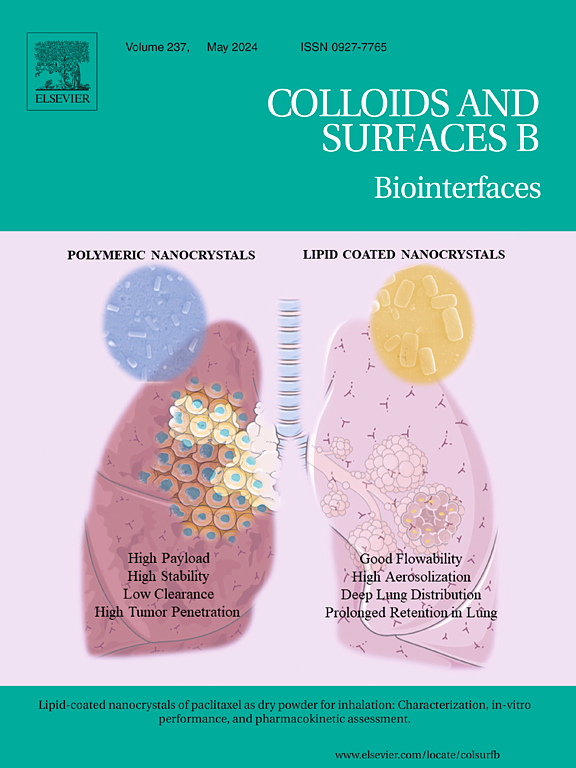优化功效:透明质酸脂质体包封米诺地尔增强透皮输送和治疗雄激素性脱发
IF 5.4
2区 医学
Q1 BIOPHYSICS
引用次数: 0
摘要
米诺地尔(Mi)是目前临床上治疗脱发最常用的药物之一。它的工作原理是加速毛囊周围的血液流动,增强局部氧气和营养供应,从而促进头发生长。然而,传统的米制剂在皮肤上停留时间短,容易引起过敏反应、结垢,甚至可能引起全身多毛。这突出表明迫切需要开发更有效和更安全的给药系统,以提高其治疗效果。在之前的研究中,我们的团队开发了一种基于高分子量透明质酸的传递平台(HL),具有优异的皮肤渗透,抗炎特性和组织修复能力。本研究以HL给药材料为载体,开发了一种药物包封效率高、生物安全性好的Mi给药系统- HL@Mi。该输送系统使用反蒸发、高速均质和微射流高压等技术将Mi封装在HL中。荧光标记和高效液相色谱(HPLC)证实HL@Mi显著增强了小米的皮肤渗透和滞留,有效提高了小米的局部生物利用度。在体外实验中,HL@Mi显著降低了小米的细胞毒性,同时通过促进血管生成和调节与毛囊功能相关的IL-6、MMP3和β-catenin基因的表达,优化了毛囊微环境。在已建立的雄激素源性脱发动物模型中,HL@Mi可显著下调皮肤中IL-6、TNF-α、TGF-β1等炎症因子的表达,上调毛囊组织中Ki67的表达,从而促进毛发生长,有效改善脱发症状。此外,HL@Mi具有良好的生物相容性和安全性。综上所述,HL@Mi作为一种新型的透皮给药系统,不仅为Mi治疗雄激素性脱发提供了一种更有效、更安全的临床替代方案,也为其他局部给药策略提供了宝贵的技术见解。本文章由计算机程序翻译,如有差异,请以英文原文为准。
Optimizing efficacy: Hyaluronic acid liposomes encapsulating minoxidil for enhanced transdermal delivery and treatment of androgenetic alopecia
Minoxidil (Mi) is currently one of the most commonly used drugs for the treatment of hair loss in clinical settings. It works by accelerating blood flow around the hair follicles, enhancing local oxygen and nutrient supply, thereby promoting hair growth. However, traditional formulations of Mi have a short residence time on the skin, are prone to causing allergic reactions, scaling, and may even induce systemic hypertrichosis as side effects. This highlights the urgent need for the development of more efficient and safer delivery systems to improve its therapeutic efficacy. In previous studies, our team developed a high molecular weight hyaluronic acid-based delivery platform (HL) with excellent skin penetration, anti-inflammatory properties, and tissue repair capabilities. In this study, we used the HL delivery material as a carrier for Mi and developed a Mi delivery system with high drug encapsulation efficiency and good biological safety—HL@Mi. This delivery system encapsulates Mi within HL using techniques such as reverse evaporation, high-speed homogenization, and microjet high-pressure methods. Fluorescent labeling and high-performance liquid chromatography (HPLC) were employed to confirm that HL@Mi significantly enhanced the skin penetration and retention of Mi, effectively improving the local bioavailability of Mi. In vitro experiments, HL@Mi significantly reduced the cytotoxicity of Mi, while optimizing the hair follicle microenvironment by promoting angiogenesis and regulating the expression of IL-6, MMP3, and β-catenin genes associated with hair follicle function. In an established androgenetic alopecia animal model, HL@Mi significantly downregulated the expression of inflammatory factors such as IL-6, TNF-α, and TGF-β1 in the skin, while upregulating Ki67 expression in the hair follicle tissue, thereby accelerating hair growth and effectively improving hair loss symptoms. Moreover, HL@Mi exhibited good biocompatibility and safety. In summary, HL@Mi, as a novel transdermal delivery system, not only provides a more efficient and safer clinical alternative for Mi in the treatment of androgenetic alopecia, but also offers valuable technical insights for other local drug delivery strategies.
求助全文
通过发布文献求助,成功后即可免费获取论文全文。
去求助
来源期刊

Colloids and Surfaces B: Biointerfaces
生物-材料科学:生物材料
CiteScore
11.10
自引率
3.40%
发文量
730
审稿时长
42 days
期刊介绍:
Colloids and Surfaces B: Biointerfaces is an international journal devoted to fundamental and applied research on colloid and interfacial phenomena in relation to systems of biological origin, having particular relevance to the medical, pharmaceutical, biotechnological, food and cosmetic fields.
Submissions that: (1) deal solely with biological phenomena and do not describe the physico-chemical or colloid-chemical background and/or mechanism of the phenomena, and (2) deal solely with colloid/interfacial phenomena and do not have appropriate biological content or relevance, are outside the scope of the journal and will not be considered for publication.
The journal publishes regular research papers, reviews, short communications and invited perspective articles, called BioInterface Perspectives. The BioInterface Perspective provide researchers the opportunity to review their own work, as well as provide insight into the work of others that inspired and influenced the author. Regular articles should have a maximum total length of 6,000 words. In addition, a (combined) maximum of 8 normal-sized figures and/or tables is allowed (so for instance 3 tables and 5 figures). For multiple-panel figures each set of two panels equates to one figure. Short communications should not exceed half of the above. It is required to give on the article cover page a short statistical summary of the article listing the total number of words and tables/figures.
 求助内容:
求助内容: 应助结果提醒方式:
应助结果提醒方式:


